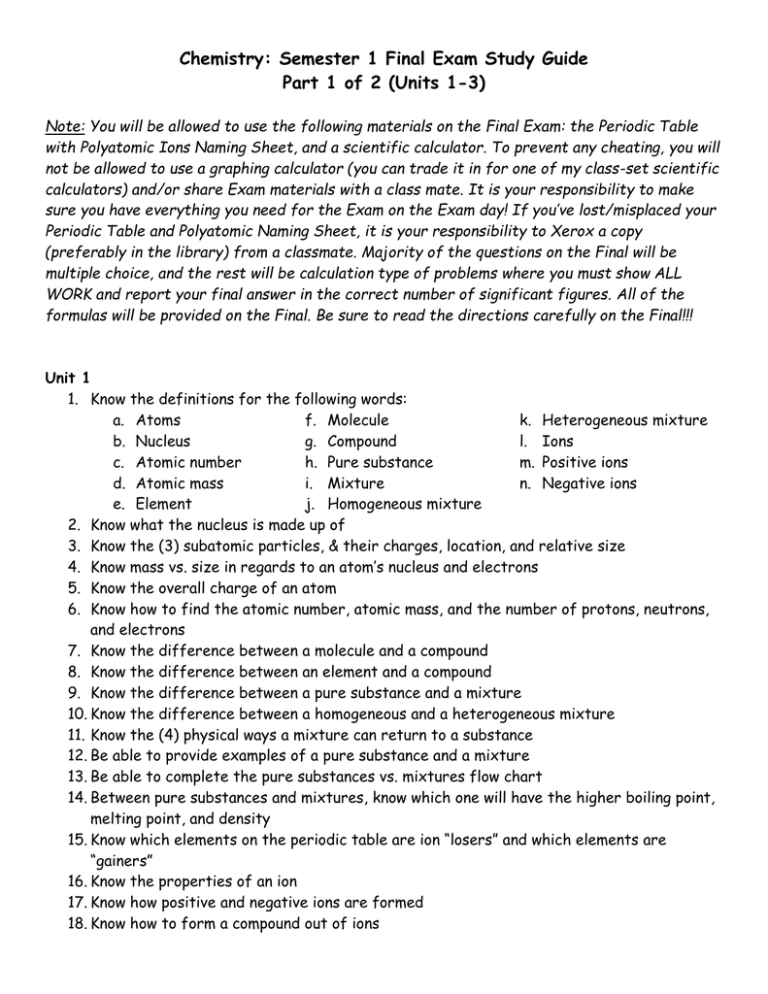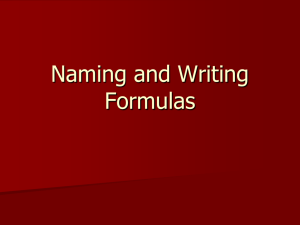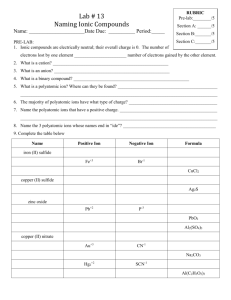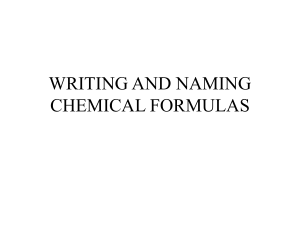Semester 1 Study Guide
advertisement

Chemistry: Semester 1 Final Exam Study Guide Part 1 of 2 (Units 1-3) Note: You will be allowed to use the following materials on the Final Exam: the Periodic Table with Polyatomic Ions Naming Sheet, and a scientific calculator. To prevent any cheating, you will not be allowed to use a graphing calculator (you can trade it in for one of my class-set scientific calculators) and/or share Exam materials with a class mate. It is your responsibility to make sure you have everything you need for the Exam on the Exam day! If you’ve lost/misplaced your Periodic Table and Polyatomic Naming Sheet, it is your responsibility to Xerox a copy (preferably in the library) from a classmate. Majority of the questions on the Final will be multiple choice, and the rest will be calculation type of problems where you must show ALL WORK and report your final answer in the correct number of significant figures. All of the formulas will be provided on the Final. Be sure to read the directions carefully on the Final!!! Unit 1 1. Know the definitions for the following words: a. Atoms f. Molecule k. Heterogeneous mixture b. Nucleus g. Compound l. Ions c. Atomic number h. Pure substance m. Positive ions d. Atomic mass i. Mixture n. Negative ions e. Element j. Homogeneous mixture 2. Know what the nucleus is made up of 3. Know the (3) subatomic particles, & their charges, location, and relative size 4. Know mass vs. size in regards to an atom’s nucleus and electrons 5. Know the overall charge of an atom 6. Know how to find the atomic number, atomic mass, and the number of protons, neutrons, and electrons 7. Know the difference between a molecule and a compound 8. Know the difference between an element and a compound 9. Know the difference between a pure substance and a mixture 10. Know the difference between a homogeneous and a heterogeneous mixture 11. Know the (4) physical ways a mixture can return to a substance 12. Be able to provide examples of a pure substance and a mixture 13. Be able to complete the pure substances vs. mixtures flow chart 14. Between pure substances and mixtures, know which one will have the higher boiling point, melting point, and density 15. Know which elements on the periodic table are ion “losers” and which elements are “gainers” 16. Know the properties of an ion 17. Know how positive and negative ions are formed 18. Know how to form a compound out of ions Unit 2 1. Know the definitions to the following words: a. nomenclature c. binary compound e. stock system ion b. ionic compound d. polyatomic ion f. nonmetal compound 2. Know the (2) types of naming groups 3. Know the (3) types of ionic compounds, and how they differ amongst one another 4. Know which type of compounds include a metal and nonmetal bond, and which type of compounds include a nonmetal and nonmetal bond 5. Know how to name and write binary compounds/formulas 6. Know how to use the “polyatomic cheat sheet” 7. Know how to name and write polyatomic compounds/formulas 8. Know when to use parentheses in polyatomic formulas 9. Know when to use stock system 10. Know how to write roman numerals for numbers 1-5 11. Know how to name and write stock system compounds/formulas 12. Know the prefixes for naming nonmetal compounds 13. Know how to name and write nonmetal compounds/formulas 14. Know where the metals and nonmetals are found on the p.t. Unit 3 1. Know the definitions to the following words: a. chemical equation e. parentheses i. single-displacement b. reactants f. coefficients j. double-displacement c. products g. synthesis k. combustion d. subscripts h. decomposition 2. Know the chemical equation symbols 3. Memorize the seven special gas elements that cannot exist by themselves 4. Know how to convert from a word equation to a chemical equation 5. Know how to count atoms 6. Know why you need to balance an equation 7. Know the rules of balancing an equation 8. Know how to balance an equation 9. Know the five types of chemical reactions, and how to identify them if given a chemical equation 10. Know how to predict the products of a chemical reaction




